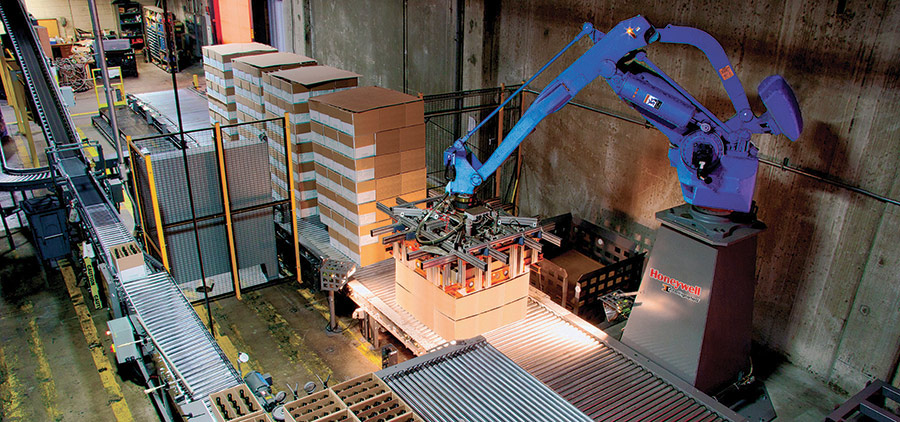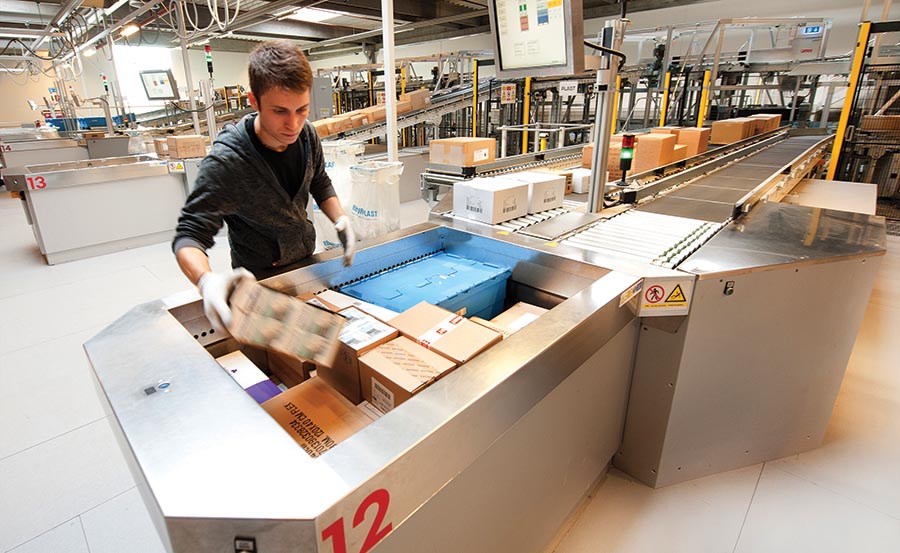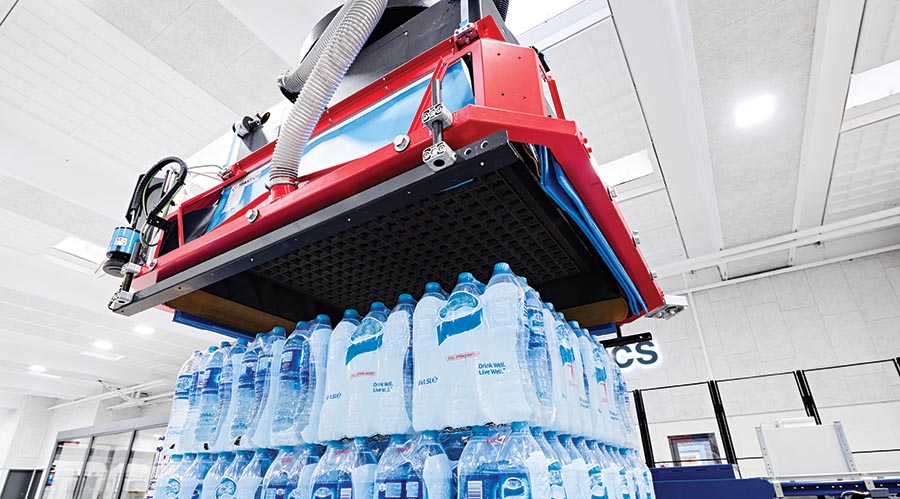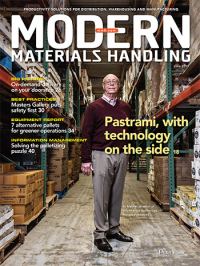Solving the Palletizing Puzzle
Palletizing presents an interesting microcosm of digital transformation, where data about products, machine performance and manual labor must work in concert.
Despite all the moving and shaking in each-picking applications, pallets underpin the majority of storage and transportation. In a connected facility, optimal palletizing means the flexibility to satisfy customers by efficiently building, stabilizing, storing, loading, moving and presenting those pallets.
Palletizing can be broken into two broad segments: manufacturing and warehousing. Production lines producing pallet after pallet of a single SKU are already largely automated. Manufacturing is predictable, and even with packaging changes you have some time to react and modify equipment, says Matt Wicks, vice president of product development for Honeywell Intelligrated. However, in distribution and retail warehousing, the challenge of palletizing automatically is different, he says, so some manual labor is almost always needed.
“If a mom and pop company is making widgets, they don’t need a highly automated system to do that,” Wicks says. “But, as order volume increases, many can’t support staffing levels so they look at automation. When palletizing, it gets to the point where they just can’t do it all manually.”
Historically, return on investment was the primary driver for investment in conventional palletizing equipment. Lift assists, lift tables and the like can help address ergonomic concerns, repetitive strain injuries and injury claims. Ray Cocozza, president of Conveyco, says employee welfare is still a big concern, but the labor shortage is pushing companies away from justifying investment solely on ROI.
“It’s hard to find people to work these jobs, and for those you can find, you want to provide a good work experience, so it comes from both directions,” says Cocozza, who emphasizes that software and data are the keys to ensuring the palletizing function works in harmony with upstream and downstream processes. The latest software is more capable, he says, and can process and group work in such a way as to minimize inefficiency between processes.

When labor is hard to come by, even small operations are considering automated palletizing solutions.
“In the 1980s, the thinking was ‘give me 4 miles of conveyor and we’ll have enough to get stuff out the door.’ Now we’re able to take the complexity of mechanization out of the equation, because we can more intelligently release work and process it within the four walls,” he says. “It comes down to being able to use software to arrange and sequence work so that resources, whether human or mechanized, are utilized optimally.”
The foundation of pallet building
It all starts with data, Cocozza says. SKU attributes are particularly critical data points, like crushable items that can destroy a pallet if placed near the bottom or caustic items that can ruin product if punctured toward the top. The complexion of products within an order and within a pallet matters, he adds. Depending on what outbound loads look like, the data will help inform a suitable amount of automation to make it work. Of course, the quality of product data varies from client to client, Cocozza says.
“Do they have the maturity and control back through their supply chain so they know things about the geometry of products and other attributes unique to each SKU? Is that information held anywhere?” Cocozza asks. “Will it be practical to go through and capture that data for a larger automation project? It’s a different project if you’re handling thousands of SKUs or if it’s closer to 100,000.”

Coordinated by intelligent software, ergonomic palletizing operations can address variability in SKUs and volume.
Raw product data isn’t always helpful without some context. Mike Khodl, vice president of global solutions for Dematic, says SKU variables are one of the biggest problems in every sector. For example, a SKU database might indicate a belt is an inch wide and 40 inches long. Then, there’s the difference between a normal bottle and a promotional one with 30% more. A human can easily stack these items, but automation needs all that info.
“There are a lot of conversations about how to do that,” Khodl says. “There’s a lot of database cleanup, and some operations have teach-in stations where they take a SKU every so often and validate it. But imagine 15,000 SKUs, and it takes 3 minutes to test each one. Develop an operating plan, because you’re not going to do it in one fell swoop every year, but you can continuously update.”
After collecting detailed product data, each company has to decide how to use it to build pallets. Depending on the industry, Cocozza says, pallets could be assembled in a store- or aisle-friendly sequence. Promotions might call for case logos to be oriented outward for presentation of the entire pallet in a store. Whatever the industry, pressure exists to build the densest possible pallet to optimize transportation spend.
“One of the big elements of a good palletizing solution, whether ergonomic or robotic, is how it impacts cube utilization for outbound trailers,” Khodl says. “It’s very cost effective when you go from 75% to 89% cube, and as long as you don’t weigh out before you cube out, that’s extremely valuable given transportation costs and trucking labor.”
Of course palletizing is not just an outbound strategy, Khodl adds. A discount apparel retailer, for example, might receive in bulk and need to palletize on the inbound side to feed into reserve storage. A liquor distributor might need to palletize a shipment of wine floor-loaded in shipping containers. In a crossdock application, it might make sense to build those rainbow or mixed-SKU pallets right at inbound. You could also pre-build parts of a pallet with an eye toward a likely future order, Khodl says.
Bend, don’t break
Some palletizing work is done manually all the time, Khodl says. An automated mixed-case palletizing machine builds perfectly sequenced pallets, but—with all the same upstream technologies—an ergonomic manual palletizing station might make more sense. “We often mix the two together in a solution,” Khodl says, “because not all SKUs are conducive to automation.”
“In the last three years, we’ve gone from 85% of SKUs to 92% to 95% that can be automated,” Khodl adds. But, it’s an ongoing challenge because of factors like weaker packaging with less cardboard and plastic can be a problem for machinery, he adds.
A lot of mixed-case palletizing solutions are focused on grocery, but there are many deployments in general merchandise as well, Khodl says. Ergonomic palletizing stations might feature a vacuum assist, slide rails around the station, or the ability to accommodate one or two workers to manage rates.
Plenty of operations rely on double or triple pallet jacks in aisles. It’s a conventional way of batch picking mixed pallets, but Khodl says it’s hard to scale up. The next level is an integrated unit load automated storage and retrieval system (AS/RS) to dynamically face pallets into a pick slot, which optimizes the picker’s travel distance. The software must be ready to manage the inventory of those dynamic slots and provide visibility to the order-processing layer to quickly optimize those slots. The next tier of sophistication is a multi-level pick-to-belt module, and the same AS/RS can handle multiple tiers. This still doesn’t support a sequenced pallet at the case level, Khodl says, but it might support grouping by family.
In an automated or fully integrated solution, an AS/RS manages full pallet storage, with an automated delivery process to an automated forward pick machine, which could be a shuttle, mini-load or Autostore. The automated forward pick system selects individual singulated case items and sequences them so they can be ergonomically or automatically palletized. Khodl says this adds another level of complexity on the software side; it has to manage individual sequences for all orders, keep replenishment triggers working properly for the work-in-process automated buffer, and coordinate some automated method to depalletize into cases and route into the automated forward pick area.
However simple or sophisticated the system, the products it handles will change. That’s why Pieter Feenstra, chief executive officer of the system integration business unit for Körber Logistics, says it’s essential that palletizing equipment be future-proof. The trick, as always, is to find the sweet spot between what is and what might be.
“A robotic arm has a fixed maximum throughput, so maybe you start with a big one and ramp up throughput over time,” Feenstra says. “This is a big pain point because customers are wary to invest in high-speed technology before the volume is actually there.”
Another option, Feenstra says, is a modular palletizer with a base machine that handles four layers per minute. It can be upgraded to six and then again to 10 layers per minute, all in the same footprint.

Palletizing is largely automated in production facilities, but the latest technologies can also handle a dynamic warehousing environment.
Maintenance
As throughput increases, so does the impact of downtime. Managing product data is one thing, but the data from the machinery itself is also rich with value. Gregor Baumeister, head of the palletizing and packaging systems division for Beumer Group, says the key is not looking at systems from a single machine perspective, but instead looking at an integrated packaging line.
Little hidden gems can emerge, Baumeister says, like the frequency of finished pallets at pickup positions waiting for forklifts, or a slip sheet roll that isn’t refilled and the line sits idle for 10 minutes.
“Without human input, the system doesn’t recognize something needs to be done,” Baumeister explains. “If the operations team is on its toes, though, and is measuring, they can set alarms or notifications and can see statistics on how the operation is performing beyond the machines. Maybe the line is available but not materials—or some other technical situation. Once identified, you can then prevent those issues.”
He describes a modular software suite for palletizing and packaging equipment that enables machines to communicate with each other more effectively. For example, product changeovers will prompt the entire line to adjust itself to whatever it’s running.
“You don’t have to set up each machine sequentially,” Baumeister says, “the system sets up automatically in parallel. If you’re in an environment where there is a higher frequency of batch changes, that can easily add up to double-digit productivity gains.”
At Honeywell Intelligrated, Wicks agrees the ability to change over quickly and reconfigure operations is a key enabler to palletizing solutions.
“It seems pretty straightforward,” Wicks says, “but years ago you would write the pallet pattern and when a change was needed a sophisticated robotic engineer had to come in. It could take weeks to adjust to a new pattern. Now users themselves can quickly make changes over the course of a shift.”
Feenstra notes that more customers are taking proactive approaches to maintenance as digitalization continues. Customers increasingly demand connected and intelligent systems because they prefer to know when a component is due for a maintenance check rather than waiting until it breaks down.
“We all supply machinery,” Baumeister adds, “but in the future the software is providing the intelligence of the machine, and software can improve how comfortable the user is interacting with the machine. Characterized by how comfortable it is to operate, set parameters, access and digest information, factors like user experience and human/machine interface are driving technology acceptance.”
Companies mentioned in this article:

Article Topics
Shipping Pallets News & Resources
Two voices of reason on pallet materials PLA Solutions Video - Stay on Top of It All Pallet recycler and services company PLA appoints Steve Clark as CEO Cobot as key ingredient for palletizing efficiency CHEP appoints Xavier Garijo to newly created CEO Americas position Pallet company Kamps announces executive team changes PLA names Jenny Bedard as new CFO More Shipping PalletsLatest in Materials Handling
Geek+ and System Teknik deploy PopPick solution for pharmacy group Med24.dk Beckhoff USA opens new office in Austin, Texas Manhattan Associates selects TeamViewer as partner for warehouse vision picking ASME Foundation wins grant for technical workforce development The (Not So) Secret Weapons: How Key Cabinets and Asset Management Lockers Are Changing Supply Chain Operations MODEX C-Suite Interview with Harold Vanasse: The perfect blend of automation and sustainability Consultant and industry leader John M. Hill passes on at age 86 More Materials HandlingAbout the Author
Subscribe to Materials Handling Magazine

Find out what the world's most innovative companies are doing to improve productivity in their plants and distribution centers.
Start your FREE subscription today.
April 2024 Modern Materials Handling

Latest Resources












